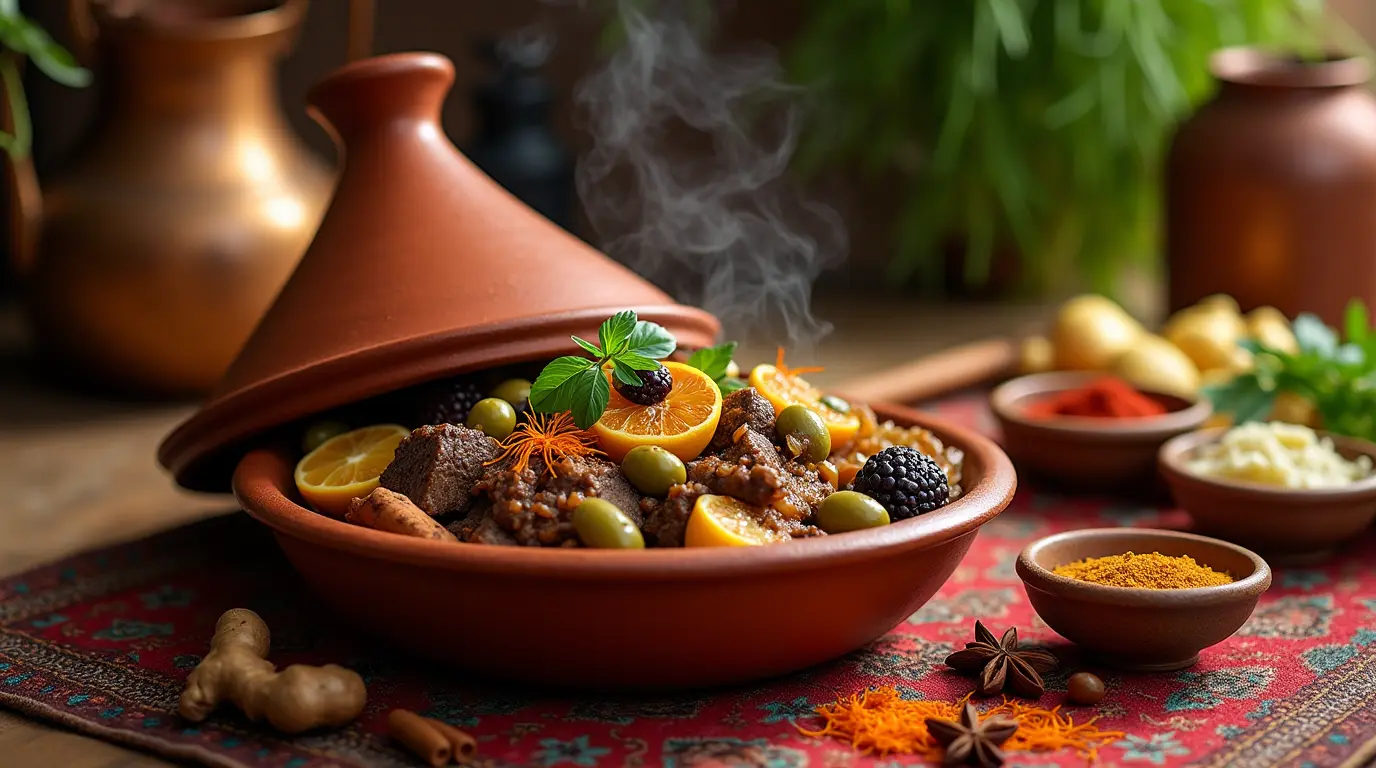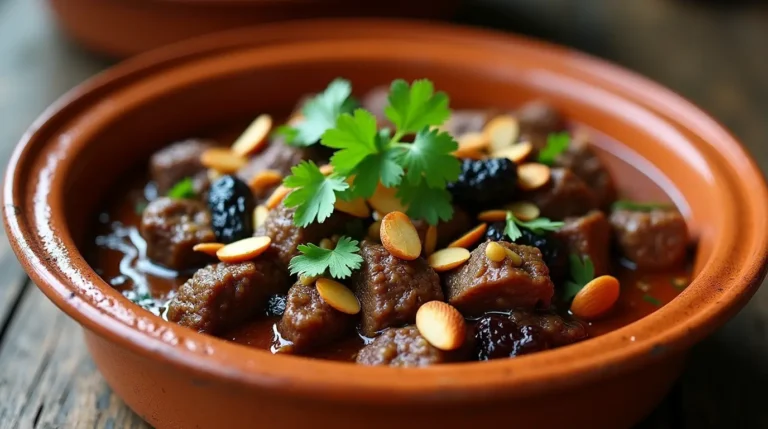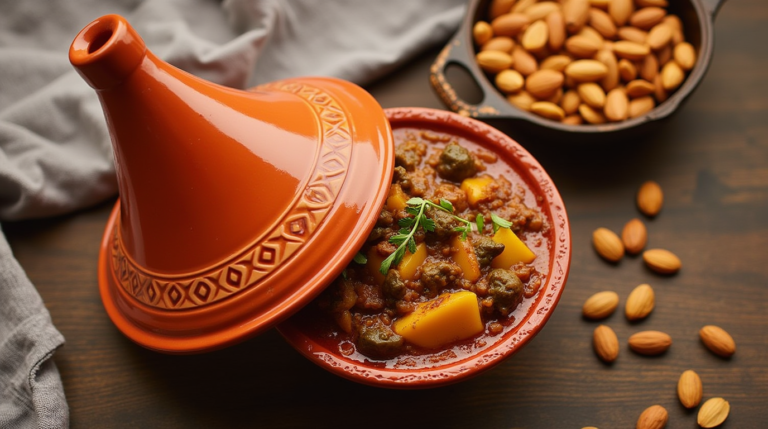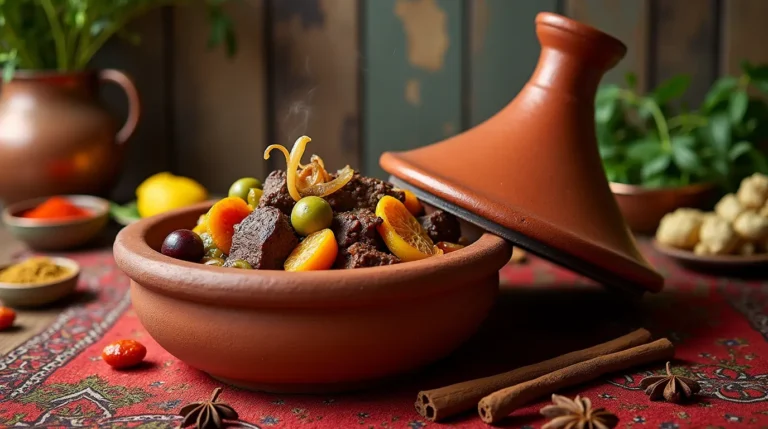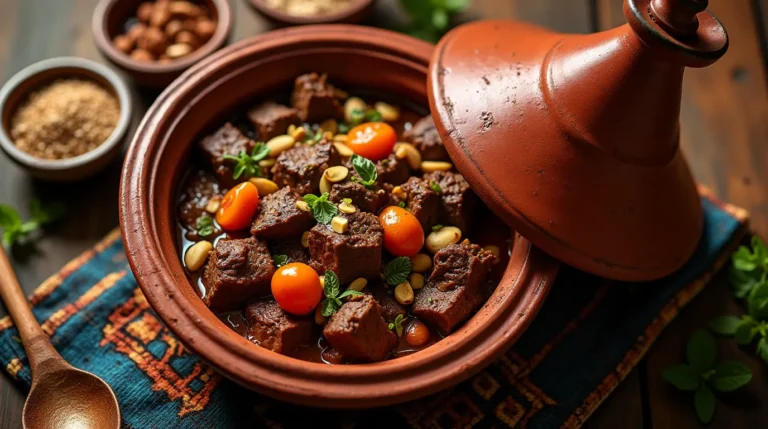Traditional Moroccan Beef Tagine: Spices, Secrets & Tips
There’s something magical about lifting the conical lid of a tagine and being enveloped by a cloud of aromatic steam that carries the essence of Morocco right into your kitchen. If you’ve ever been fortunate enough to visit this beautiful North African country, you know that a tagine isn’t just food—it’s an experience. Today, I’m excited to share with you the authentic way to prepare a traditional Moroccan beef tagine, complete with all the spices, secrets, and tips that have been passed down through generations.
Whether you’re a seasoned home cook looking to expand your culinary horizons or someone who fell in love with this dish during travels and wants to recreate it at home, this step-by-step guide will walk you through the process of creating a mouthwatering, tender beef tagine that will transport you straight to the bustling markets of Marrakech.
What Makes a Tagine Special?
Before we dive into the cooking process, let’s talk about what makes this dish so unique. A tagine refers to both the conical earthenware pot in which the dish is cooked and the slow-cooked stew itself. The genius of the tagine pot’s design is that it allows steam to circulate during cooking, condensing at the top and falling back down into the dish, creating an incredibly moist and tender result.
While traditionally cooked over hot coals, don’t worry—we’ll be adapting this recipe for modern kitchens without sacrificing any of the authentic flavors. So, let’s gather our ingredients and embark on this flavorful journey together!
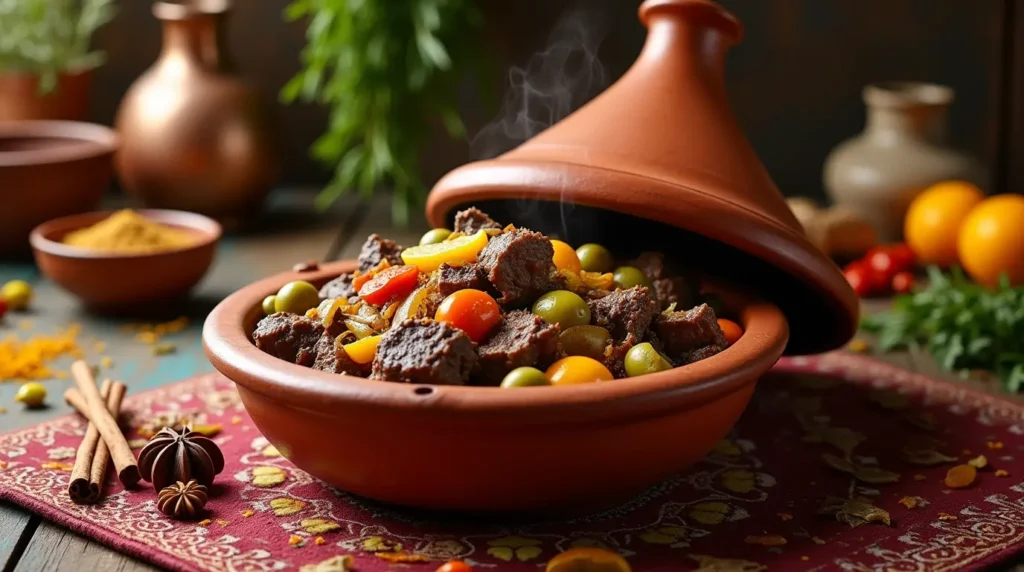
Ingredients (Serves 4-6)
For the meat and marinade:
- 2 pounds (900g) beef chuck or shoulder, cut into 1.5-inch cubes
- 2 tablespoons olive oil
- 1 tablespoon ras el hanout (Moroccan spice blend)
- 1 teaspoon ground cumin
- 1 teaspoon ground coriander
- 1 teaspoon sweet paprika
- 1/2 teaspoon ground cinnamon
- 1/2 teaspoon ground ginger
- 1/4 teaspoon ground turmeric
- 1/4 teaspoon cayenne pepper (adjust to taste)
- 3 cloves garlic, minced
- Fresh juice of 1/2 lemon
- Salt and black pepper to taste
For the tagine:
- 2 large onions, thinly sliced
- 3 carrots, peeled and cut into chunks
- 2 medium potatoes, peeled and cut into chunks (optional)
- 1 red bell pepper, deseeded and cut into chunks
- 1 cup dried apricots, halved
- 1/2 cup prunes, pitted
- 1/3 cup green olives, pitted
- 2 tablespoons honey
- 1 cinnamon stick
- 2 bay leaves
- 2 cups beef or vegetable stock
- 1 can (14 oz) diced tomatoes
- 1/4 cup fresh cilantro, chopped
- 1/4 cup fresh parsley, chopped
- 2 tablespoons fresh mint, chopped
- 1/3 cup sliced almonds, toasted (for garnish)
Steps to Tagine Perfection
1. Marinate the Beef
The key to a flavorful Beef Tagine starts with a good marinade. In a large bowl, combine your beef cubes with olive oil, ras el hanout, cumin, coriander, paprika, cinnamon, ginger, turmeric, cayenne pepper, minced garlic, lemon juice, salt, and black pepper. Using your hands (wear gloves if you prefer), massage the spices into the meat until each piece is well coated.
Cover the bowl with plastic wrap and let it marinate in the refrigerator for at least 4 hours, but preferably overnight. This marinating time is crucial as it allows the meat to absorb all those wonderful flavors and begin the tenderizing process. If you’re short on time, even 1-2 hours will make a difference, but the longer, the better!
Pro tip: Ras el hanout is a complex Moroccan spice blend that can include up to 30 different spices. If you can’t find it, you can make a simplified version by combining equal parts ground cumin, coriander, ginger, and paprika with a pinch of cinnamon and cayenne.
2. Prepare Your Beef Tagine Pot (or Alternative)
If you own a traditional clay tagine pot, you’ll need to prepare it before first use. If it’s unglazed, soak it in water for at least 2 hours, then dry and rub the inside with olive oil. This prevents cracking when heated.
If you’re using a previously used Beef Tagine pot, simply rub a little olive oil on the inside before cooking. Place a diffuser on your stovetop if you’re using a gas or electric range to prevent the clay from cracking.
Don’t have a tagine pot? No problem! A Dutch oven or any heavy-bottomed pot with a tight-fitting lid works wonderfully as well. The key is slow, moist cooking, which these alternatives can provide.
Pro tip: Traditional clay tagines shouldn’t be subjected to rapid temperature changes. Always start with low heat and gradually increase it. If you’re using a modern Beef Tagine pot specifically designed for stovetop use, check the manufacturer’s instructions.
3. Brown the Meat
Remove the marinated meat from the refrigerator and let it come to room temperature for about 30 minutes. This ensures more even cooking.
Heat a tablespoon of olive oil in a large skillet over medium-high heat. Working in batches to avoid overcrowding (which would steam rather than sear the meat), brown the beef on all sides. This should take about 2-3 minutes per batch.
As each batch finishes, transfer the meat to a plate and set aside. Don’t worry about cooking the meat through at this stage—we’re just developing flavor through the browning process.
Pro tip: Be patient with the browning process. It’s tempting to stir the meat constantly, but letting each side develop a nice sear before turning is what creates that deep, complex flavor we’re looking for.
4. Prepare the Base
In the same skillet used for browning the meat (don’t clean it—those browned bits are flavor gold!), add a little more oil if needed and lower the heat to medium. Add the sliced onions and a pinch of salt.
Cook the onions, stirring occasionally, until they become soft and golden brown, about 10-15 minutes. This slow caramelization process creates a sweet, rich foundation for your Beef Tagine.
In the last minute of cooking, add the minced garlic and stir until fragrant. Be careful not to burn the garlic as it can turn bitter.
Pro tip: The caramelized onions form the foundation of your tagine’s flavor. Don’t rush this step—properly caramelized onions should be soft, sweet, and golden brown. This slow cooking process releases their natural sugars, adding incredible depth to your dish.
5. Assemble the Beef Tagine
Now comes the fun part—assembling your tagine! If using a traditional Beef Tagine pot, transfer the caramelized onions to form the bottom layer. If using a Dutch oven or similar pot, you can do the same.
Arrange the browned meat over the onions, then add the carrots, potatoes (if using), and bell peppers around the meat. Pour in the diced tomatoes and stock, making sure not to fill the Beef Tagine more than two-thirds full.
Scatter the dried apricots, prunes, and green olives over the top. Add the cinnamon stick and bay leaves, then drizzle with honey. The combination of sweet and savory elements is characteristic of Moroccan cuisine and creates a beautifully balanced flavor profile.
Pro tip: In Moroccan cuisine, it’s traditional to arrange the ingredients in an aesthetically pleasing way. While this won’t affect the flavor, it does make for a beautiful presentation when you remove the lid at the table!
6. Slow Cook to Perfection
Now for the most important part of making a Beef Tagine—the slow cooking. Cover your tagine pot with its conical lid, or your Dutch oven with its lid. If using a traditional clay tagine on the stovetop, place it on a diffuser over low heat.
Bring the liquid to a gentle simmer (you should see just a few bubbles breaking the surface), then reduce the heat to maintain that same gentle simmer. Let it cook undisturbed for 2.5-3 hours. The long, slow cooking time allows the meat to become incredibly tender and for all the flavors to meld together.
If using a conventional oven, preheat to 325°F (165°C) and place your covered Dutch oven or tagine (if oven-safe) inside for the same amount of time.
Pro tip: Resist the urge to lift the lid and peek! Each time you do, you release precious steam and heat, potentially increasing the cooking time. Trust the process and let the magic happen undisturbed.
7. Check for Doneness
After about 2.5 hours, carefully remove the lid (watch out for the steam!). Test the meat with a fork—it should be fork-tender and practically falling apart with minimal resistance. If not, cover and continue cooking for another 30 minutes.
This is also the time to check the consistency of your sauce. If it’s too watery, remove the lid and simmer for 10-15 minutes to reduce and thicken the sauce. If it’s too thick, add a little more stock or water.
Taste and adjust the seasoning as needed. You might want to add more salt, pepper, or even a touch more honey if you prefer a slightly sweeter profile.
Pro tip: The Beef Tagine is traditionally served with the sauce quite liquidy, perfect for sopping up with bread. However, if you prefer a thicker sauce, you can leave it uncovered for the last 15-20 minutes of cooking.
8. Add Fresh Herbs
Just before serving, stir in most of the chopped cilantro, parsley, and mint, reserving some for garnish. The fresh herbs add a bright, lively contrast to the rich, slow-cooked flavors of the tagine.
This last-minute addition of herbs is crucial—if added earlier, they would lose their vibrant color and fresh flavor during the long cooking process.
Pro tip: In Morocco, fresh herbs are used generously. Don’t be shy with them—they bring a wonderful freshness that balances the rich, spiced nature of the dish.
9. Garnish and Serve
Toast your sliced almonds in a dry skillet until golden brown, watching carefully to prevent burning. Sprinkle these over the Beef Tagine along with the remaining fresh herbs.
Traditionally, the tagine is brought to the table still in its cooking vessel, with the lid dramatically removed at the table to release the aromatic steam—a true sensory experience for your guests!
Serve your Beef Tagine with warm, crusty bread (khobz) for soaking up the delicious sauce, or with fluffy couscous on the side. Garnish with lemon wedges for an optional fresh, acidic note.
Pro tip: In Morocco, tagine is often eaten communally, with each person eating from the section of the dish directly in front of them, using pieces of bread instead of utensils. While you can certainly serve it on individual plates, there’s something special about the communal experience if you’re feeling adventurous!
10. Pair and Enjoy
Complement your Beef Tagine with traditional Moroccan sides such as a simple salad of cucumbers, tomatoes, and onions dressed with lemon juice and olive oil. For an authentic experience, serve sweet mint tea in small glasses for sipping throughout the meal.
Take time to enjoy this labor of love. A properly prepared Beef Tagine is not just about the flavors—it’s about the entire experience, the coming together of family and friends to share food prepared with care and attention.
Pro tip: In Morocco, mint tea is traditionally served very sweet. If that’s not to your taste, adjust the sweetness to your preference. The contrast between the sweet tea and the complex, savory tagine is part of the traditional experience.
Final Thoughts
Making an authentic Moroccan Beef Tagine is a labor of love, but one that rewards you richly with incredible flavors and a truly special dining experience. The beauty of this dish lies in its patience—the slow marinating, the careful browning, the gentle simmering that creates fork-tender meat and a sauce infused with complex spices, sweet fruits, and savory elements.
While I’ve provided a traditional recipe, don’t be afraid to make it your own. Tagines are wonderfully adaptable—you could use lamb instead of beef, add chickpeas for extra protein, or swap the dried fruits based on what you have available. The key elements are the aromatic spices, the slow cooking method, and the balance of sweet and savory components.
I hope this guide helps you create a tagine that transports you to the vibrant streets of Morocco, if only for one meal. Share your experiences in the comments below—I’d love to hear how your tagine adventure turns out!

